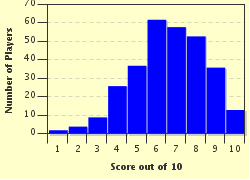Quiz Answer Key and Fun Facts
1. Which one of the following statements about kangaroos is NOT true?
2. Which of the following options is an antelope whose horns are often used to make musical instruments?
3. The orca, also known as a killer whale, is often called an apex predator, which most closely means which of the following things?
4. Which of the following carnivores would most likely be seen hunting the fleet-footed kongoni in the wild?
5. The klipspringer is a small deer found on Prince Edward Island in Canada, and nowhere else.
6. The kinkajou is an amazing animal that can do all of these things except:
7. Which of the following things make up the majority of a koala's diet?
8. In which mountain range might you expect to see a kiang walking around?
9. This happy face belongs to a kuvasz, a small wild bear that indigenous to the mountains of Hungary.
10. Which of the following is a widely distributed wild cat of Africa and Asia Minor?
Source: Author
dcpddc478
This quiz was reviewed by FunTrivia editor
Tizzabelle before going online.
Any errors found in FunTrivia content are routinely corrected through our feedback system.

